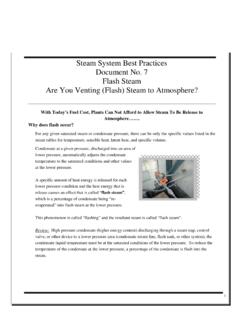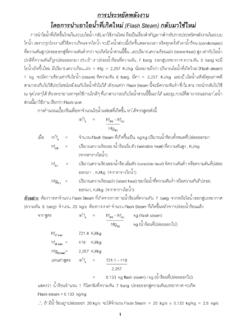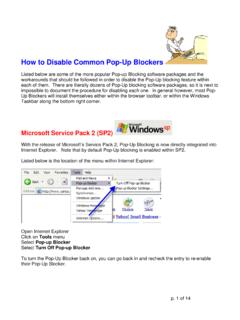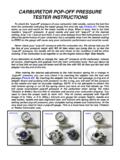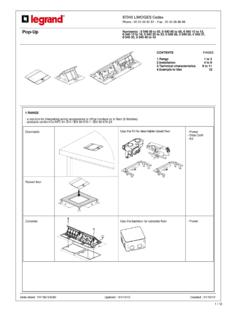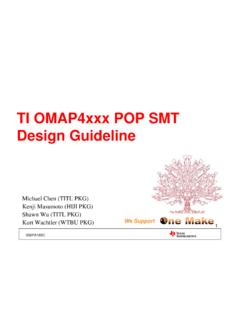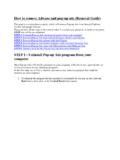Transcription of POP Safety Valve - interflow-th.com
1 POP Safety Valve POP Safety Valve INTRODUCTION. The effects of exceeding safe pressure levels in an unprotected pressure vessel or system, can have catastrophic effects on both plant and personnel. Safety relief valves should be used to protect any pressurised system from the effects of exceeding its design pressure limit. A Safety relief Valve is designed to automatically discharge gas, vapour or liquid from any pressure containing system, preventing a predetermined safe pressure being exceeded, and protecting plant and personnel. Safety Valve A Valve which automatically discharges gases and vapours so as to prevent a predetermined safe pressure being exceeded. It is characterised by a rapid full opening action and is used for steam, gases or vapour service. Relief Valve A Valve which automatically discharges fluid, usually liquid, when a predetermined upstream pressure is exceeded.
2 The term is commonly used for pressure relieving valves in which the lift is proportional to the increase in pressure above the set pressure. Safety Relief Valve A Valve which will automatically discharge gases, vapours or liquids, to prevent a predetermined safe pressure being exceeded. It is characterised by a rapid opening action. DEFINITIONS. Set Pressure The pressure measured at the Valve inlet at which a Safety relief Valve should commence to lift under service conditions. Overpressure The pressure increase above set pressure at the Valve inlet at which the discharge capacity is attained. Usually expressed as a percentage of set pressure. Accumulation The pressure increase over a maximum safe working pressure of the vessel or system when the Safety relief Valve is discharging at its rated capacity is called accumulation. The term refers to the vessel or system to be protected and not to the Valve .
3 Accumulation is the same as over-pressure when the Valve is set at the design pressure of the vessel. Re-Seat Pressure The pressure measured at the Valve inlet at which the Safety relief Valve closes. Blow-Down The difference between the set pressure and the re-seating pressure expressed as a percentage of the set pressure or as a pressure difference. Simmer The pressure zone between the Valve set pressure and the popping pressure. In this pressure zone the Valve is only slightly open and therefore discharging a small percentage of its rated capacity. Popping Pressure The pressure at which the Valve disc rapidly moves from a slightly open (simmer) position to a practically full open position. Superimposed Back Pressure Pressure higher than atmosphere in the Safety relief Valve outlet. This may result from discharge into the common disposal system of other Safety relief valves or devices, or as a result of a specific design requirement.
4 Back pressure can be either constant or variable depending on the operating conditions. Built Up Back Pressure The pressure existing at the outlet of a Safety relief Valve caused by flow through the Valve into the disposal system. Differential Set Pressure This is the difference between the set pressure and the constant superimposed back pressure. It is applicable only when a conventional type Safety relief Valve is used to discharge against constant superimposed back pressure. (It is the pressure at which the Safety Valve is set at on the test bench without back pressure.). Cold Differential Set Pressure The pressure at which a Safety relief Valve , intended for high temperature service, is set on a test rig using a test fluid at ambient temperature. The cold differential test pressure will be higher than the set pressure, in order to compensate for the effect of elevated temperature on the Valve .
5 Valve Lift The actual travel of the Valve disc away from the seat when the Valve is relieving. Discharge Capacity Actual rate of discharge of service media, which can be expressed in mass flow or volumetric terms. Equivalent Capacity Calculated mass or volumetric flow rate of the Valve of a given test fluid. The fluids commonly used for test purposes are steam, air and water. Safety RELIEF VALV E APPLICATIONS. Application Medium Safety Relief Valve Type Vented boilers Hot Water 706. Un-vented boilers 716. 746/766. Pop 716T. Boiler, pipeline and Steam 706/716. vessel protection 746. 756/766. Pop 1640B. 300. Compressor pipeline Air 706. and receiver protection 716. 746. POP. 1640B. 300. Pipeline and vessel Cold Water 706. protection 716. 746. 1640B. 300. Pump Protection Liquids 480/485. Process pipeline, pump Process/Corrosive Liquids 716 Stainless steel and vessel protection 746 Stainless steel 490 Stainless steel Clean steam and Steam and Gases 716 Stainless steel hygienic environments 746 Stainless steel Pipework, tank and Cryogenic Gases 776.
6 Equipment protection Pipework, tank and Cold & Fine Gases 716. equipment protection 776. Blowers, bulk transfer, Air 616D. tank duty, road/rail transfers The selection of figure number for each application depends on: Pressure - capacity - material - temperature - fluid - connection required. POP TECHNICAL SPECIFICATION. Safety Valve Approvals BS6759 Pt 1, 2, & 3. PED certified Category IV. Materials Body - Bronze (-59 to 224oC). Trim - Bronze Size Range Orifice Min (Barg) Max (Barg). Size mm2 Pressure Pressure DN15 (1/2") 126 24. DN20 (3/4") 285 24. DN25 (1") 507 24. DN32 (1-1/4") 791 24. DN40 (1-1/2") 1140 24. DN50 (2") 2027 24. DN65 (2-1/2") 3167 12. Performance Over Blow Kdr pressure down Steam 10% 15%*. Air / Gas 10% 15%*. *or Barg min Maximum Back Pressure Barg Constant 10%. Built-up 10%. Variable 0%. (Total % must not exceed Barg shown). Connections Screwed In x Screwed Out Construction Bottom Guided Cap Options Open lever Pressure tight dome Sizing Refer to Capacity Charts DESIGN.
7 The pop-type Safety Valve is designed to give high discharge capacity. Bottom guided design, good reseating characteristics and adjustable blowdown control ensures stable performance. Test levers are available for inline Safety checking, alternatively a sealed dome can be supplied for service conditions requiring a pressure tight seal on the discharge line. PARTS ITEM PART MATERIAL. 1 Seat Bronze 2 Valve Disc Bronze 3 Body Bronze 4 Spindle Brass 5 Spring End Plate Brass 6 Spring C. S. 7 Adjusting Screw Brass 8 Blowdown Ring Bronze 9 Setting Screw Brass 10 Dome Nylon 11 Lock Nut Brass 12 Lever Bronze 13 Ball St. St. Note: The 65mm Valve has a bolted body design and replaceable seat DIMENSIONS. DIMENSIONS. Valve Valve Inlet & Outlet C' C' Weight Type Size (BSP) A Dome Lever D (kg). DN15 1/2" 49 137 154 33 1. Male x Female DN20 3/4" 57 147 172 40 1. DN25 1" 64 186 212 48 2.
8 DN32 1-1/ 4" 78 195 222 57 3. DN40 1-1/2" 83 207 235 65 3. DN50 2" 105 262 293 79 6. DN65 2-1/2" 106 322 360 106 9. All dimensions in mm. FIGURE NUMBERING. SIZE (mm) CONNECTIONS CAP FIGURE No. Screwed Dome 3373. 15 to 50. Male x Female Lever 3376. 1643. Screwed Dome 3373A. 65. Male x Female Lever 3376A. AIR CAPACITY CHART (l/s) @ 10% Overpressure and 15oC. Useful Conversions Nm3/hr = 1/sec x SCFM = 1/sec x Other Gases If you wish to use the Valve on other compatible gases, the sizing details above can be used. The Valve capacity will however change depending on the specific gravity of the flowing gas. Multiply the Valve air capacity by 1/ SG to give the gas capacity. SG = specific gravity (relative to air = 1). SATURATED STEAM CAPACITY CHART (kg/h) @ 10% overpressure Useful Conversions lbs/h = kg/h x Other Temperatures The steam tables on these pages are based on saturated steam, at the temperatures shown.
9 For steam systems operating at higher temperatures, the above capacities will need to be derated by using the super heat correction factor. INSTALLATION. Safety Relief valves should always be installed in an upright position with their spring chamber vertical. All packing materials should be removed from the Valve connections prior to installation. Pressure Vessels When fitting a Safety Relief Valve onto pressure vessels, the inlet connection pipe should be as short as possible and the bore should be at least equivalent to the nominal bore size of the Valve . The pressure drop between the vessel and the Valve should be no more than 3% at rated capacity. A pressure-tight dome should be specified when: 1) A back pressure must be contained within the relieving system. 2) A head of liquid is built up within the Valve body and consequently needs to be contained. 3) The relieving medium is toxic, corrosive or environmentally unfriendly.
10 Pipelines When fitting a Safety Relief Valve into a pipeline, the inlet connecting pipe leading from the main pipeline to the Safety Relief Valve should be as short as possible, so that the inlet pressure drop is no more than 3% of rated capacity. In addition, it is advised that the Safety Relief Valve is placed a sufficient distance downstream of the pressure source. This will protect the Valve from the adverse effects of pressure pulsations. Discharge Pipelines These should be equal to or larger than the Valve outlet, with adequate supports, minimum number of bends and overall length. Unless balanced bellows valves are installed, the maximum built up backpressure should not exceed 10% of the set pressure, although the 746, 756 and the 766 can handle higher back pressure if required. Steam service valves should be adequately drained. Alignment of the discharge or drain should present no risk to persons or property.
